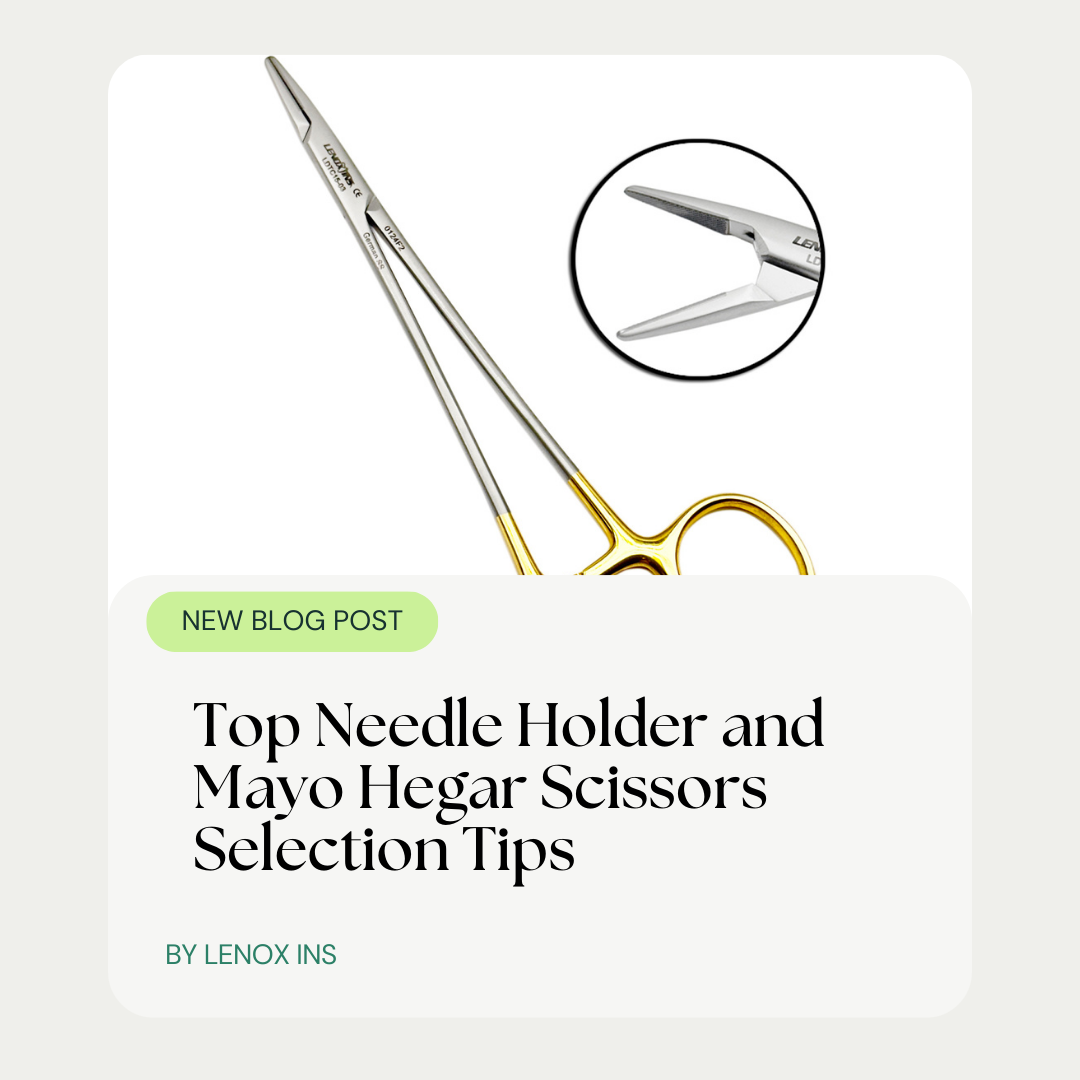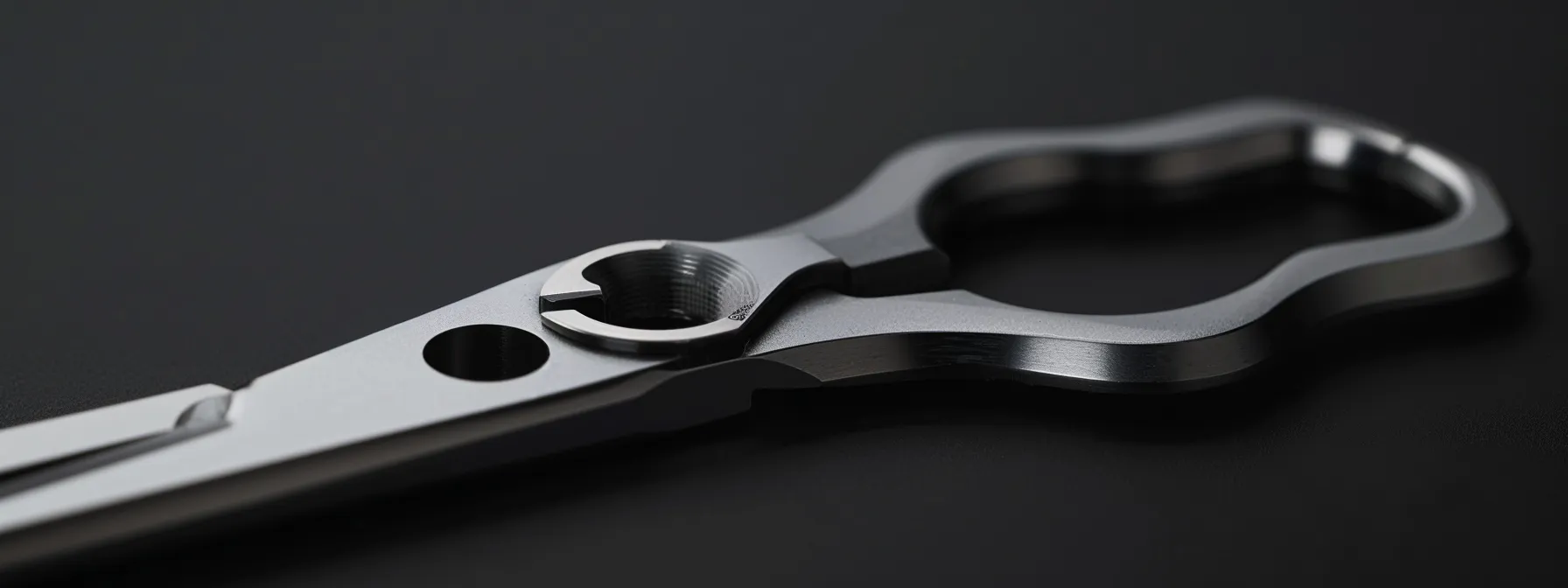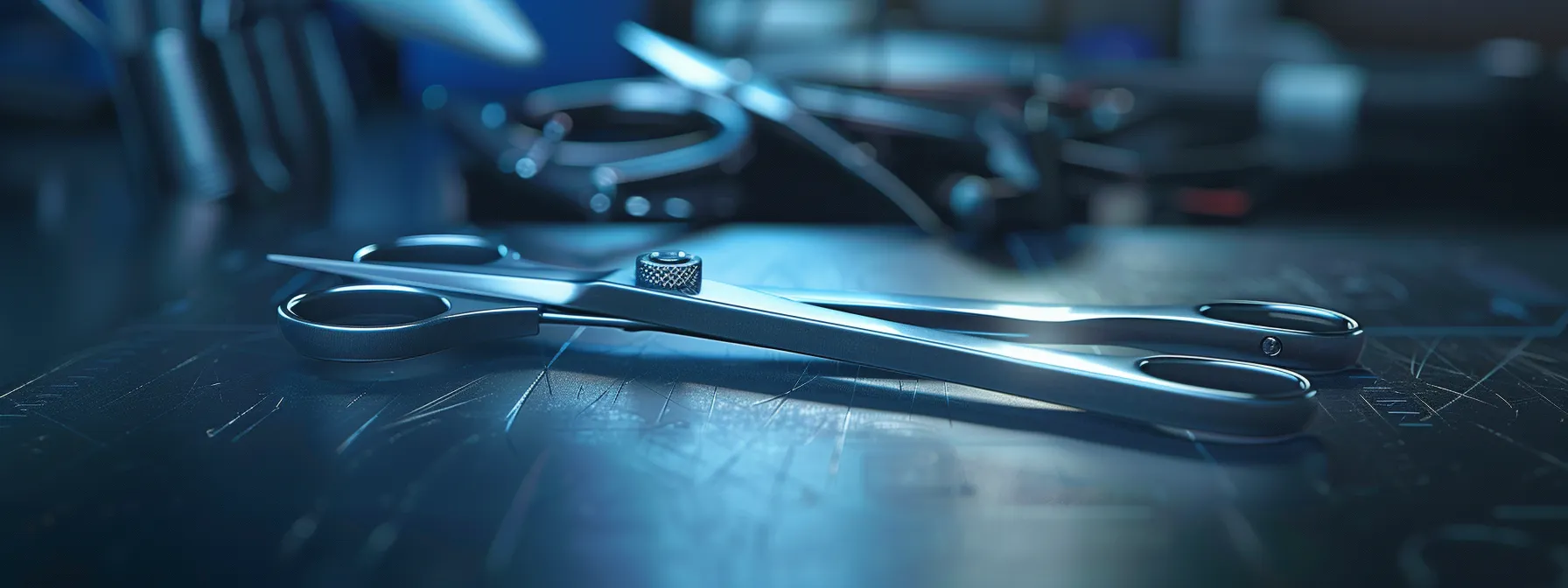Top Needle Holder and Mayo Hegar Scissors Selection Tips
- lenoxinstro
- October 30, 2024
- Dental Instruments, Dental Surgical, Needle Holder

Choosing the right needle holders with scissors can significantly impact the efficiency of stitch removal in surgical procedures, particularly in orthopedic surgery. This guide will cover key features to consider, compare various types, and outline steps for selecting the best option for your needs. Readers will learn how to enhance their surgical toolkit, ensuring precision and ease during sterilization processes. By addressing pain points such as difficulty in handling tools or ineffective stitch removal, this content aims to improve surgical outcomes and streamline workflows for medical professionals.
Key Takeaways
- Needle holders with integrated scissors enhance efficiency in stitch removal procedures
- Material quality and ergonomic design are crucial for instrument performance and comfort
- Regular maintenance and inspections ensure optimal instrument functionality and patient safety
- Selecting the right needle holder type improves precision in diverse surgical environments
- Professional recommendations help identify reliable options for surgical instruments
Understanding Needle Holders With Scissors for Stitch Removal

Needle holders with integrated scissors represent a crucial type of surgical instrument designed for enhanced efficiency in stitch removal. These combination tools offer the advantages of multifunctionality, streamlining processes and reducing instrument turnover. Common applications include various medical procedures where precision is vital, often utilizing materials such as steel and wire, alongside accompanying tools like spatulas and chisels. This section examines these essential components in detail, covering their definitions, benefits, and practical uses in clinical settings.
Defining Needle Holders With Integrated Scissors
Needle holders with integrated scissors are specialized surgical instruments that facilitate efficient stitch removal during medical procedures. Crafted from materials such as stainless steel and tungsten, these tools ensure durability and precision, essential for tasks involving delicate tissue handling. Often utilized in procedures like liposuction, the design not only enhances functionality but also helps to minimize the overall instrument cost, making them a valuable addition to any surgical toolkit:
- Combination of needle holding and cutting functions
- Durable materials for prolonged use
- Essential for procedures involving delicate tissues
- Cost-effective solution for surgical environments
Advantages of Using Combination Instruments
The advantages of using combination instruments, such as needle holders with scissors, are significant in surgical environments. These tools not only streamline the workflow by reducing the number of instruments needed but also enhance precision during procedures. For instance, the integration of tungsten carbide ensures sharp cutting edges and durability, which is essential when working with delicate tissues. Moreover, such instruments allow for improved finger placement and stability, making the use of a hemostat or rongeur more efficient during surgery. As a result, clinicians can execute procedures with greater confidence and competence, ultimately leading to better patient outcomes.
Common Applications in Medical Procedures
Needle holders with scissors play a vital role in various medical procedures, particularly in surgical fields such as rhinoplasty, where precision is essential. Surgeons commonly use these instruments to efficiently remove stitches from wounds, ensuring minimal trauma to surrounding tissues. With options made from durable materials like titanium, these tools provide the necessary strength and sharpness to enhance the surgical workflow, allowing for smoother transitions between tasks on the surgical cart.
Choosing the right tool is essential for efficient stitch removal. The next steps reveal key features to look for in needle holders with scissors that will enhance your sewing experience.
Key Features to Consider When Choosing Needle Holders With Scissors

Material quality and durability are crucial when selecting needle holders with scissors, as corrosion resistance significantly impacts instrument longevity. An ergonomic design enhances control and comfort during use, catering to the hand and thumb positioning of the surgeon. Various locking mechanisms ensure stability, while compatibility with different needle sizes allows for versatility. Each of these features contributes to efficient stitch removal in clinical settings.
Material Quality and Durability
When selecting needle holders with scissors, material quality and durability are paramount. Surgical-grade stainless steel is often favored because it combines strength with corrosion resistance, ensuring longevity in high-demand settings. For practitioners utilizing tools like Webster needle holders and forceps, the ability to withstand repeated sterilization cycles without degradation is critical, as is the reliability of mechanisms such as the ratchet system that provides secure closure. Ultimately, investing in high-quality materials not only enhances the performance of these instruments during stitch removal but also contributes to better patient care outcomes.
Ergonomic Design for Comfort and Control
The ergonomic design of needle holders with scissors plays a crucial role in enhancing comfort and control during surgical procedures, directly impacting the efficiency of stitch removal. Proper hand positioning accommodates the use of various surgical instruments, such as scalpels and speculums, reducing strain on the surgeon’s hand. Practitioners should also consider warranty options when selecting these tools, as high-quality designs often incorporate durable materials, which can include plastic components for reduced weight, ensuring prolonged usability without discomfort.
Types of Locking Mechanisms
When selecting needle holders with scissors for plastic surgery or other medical procedures, understanding the types of locking mechanisms is crucial. These mechanisms play a significant role in ensuring that the instrument remains secure during use, which is vital for producing precise outcomes. Options typically include ratchet locks, which provide a firm grip and allow for easy adjustments, and spring-loaded locks, which offer quick release and re-engagement for more fluid manipulation. The choice between these can affect the comfort and effectiveness of a surgeon‘s technique, allowing for a smoother workflow and improved handling during challenging procedures:castroviejo needle holders
- Ratchet locks for secure gripping
- Spring-loaded locks for quick adjustments
- Impact on comfort and efficiency in surgical settings
- Importance in enhancing the effectiveness of needle holders with scissorsa
- needle holder is used to?
are mayo or olsen needle holders better for minor surgery?
are mayo or olsen needle holders better for minor surgery?
When it comes to performing minor surgeries, the choice between Mayo and Olsen needle holders plays a crucial role in ensuring optimal precision and control. Mayo needle holders are known for their robust and heavy-duty construction, making them ideal for tasks that require a firm grip and strong holding capacity. They are particularly well-suited for working with heavy sutures or tough tissues, providing surgeons with the stability and leverage needed to execute precise stitching techniques.
On the other hand, Olsen needle holders are designed with a more delicate touch in mind. These needle holders feature a finer build and narrower jaws, allowing for greater dexterity and maneuverability during more intricate procedures. Surgeons often prefer Olsen needle holders for cases that involve delicate tissues or intricate suturing patterns, as they offer enhanced control and finesse in handling smaller needles and sutures with precision.
Ultimately, the choice between Mayo and Olsen needle holders depends on the specific requirements of the surgery at hand. Surgeons must consider factors such as the type of tissue being worked on, the size of the needles and sutures being used, and the level of precision and control needed to determine which needle holder will best serve their needs. By understanding the unique strengths of each type of needle holder, surgeons can make an informed decision that enhances the overall success and outcomes of minor surgical procedures.
Compatibility With Various Needle Sizes
Compatibility with various needle sizes is a critical factor in selecting needle holders with scissors. These instruments must accommodate different needle types used in diverse medical procedures to ensure efficient stitch removal. Surgeons opting for needle holders that can securely grip both large and small needles can significantly enhance their precision during operations, reducing the risk of accidental tissue damage and improving overall patient care outcomes.
Understanding the key features is just the beginning. Next, it is essential to compare the various types available to find the right fit for your needs.
Comparing Different Types of Needle Holders With Scissors

Understanding the different types of needle holders with scissors is essential for selecting the best option for efficient stitch removal. This section covers the Olsen-Hegar Needle Holders, highlighting their overview and benefits; the Mayo-Hegar Needle Holders, focusing on their appropriate use; and the Mathieu Needle Holders, discussing their unique features. Each type will be evaluated to assist in making an informed decision based on specific surgical needs.
Olsen-Hegar Needle Holders: Overview and Benefits
Olsen-Hegar needle holders are designed with integrated scissors, making them an efficient tool for stitch removal during surgical procedures. This combination allows surgeons to grasp sutures securely while also providing the capability to cut them without switching instruments, thereby enhancing workflow efficiency. Their ergonomic construction promotes comfort during prolonged use, which is vital in surgeries that require precision and sustained focus. Castroviejo needle holders
Mayo-Hegar Needle Holders: When to Use Them
Mayo-Hegar needle holders are particularly useful in surgeries where precise manipulation is necessary, such as in suturing skin or internal tissues. Their design features a strong grip and a blunt tip, making them ideal for holding larger needles securely while also maintaining control during suturing. Surgical professionals often prefer Mayo-Hegar holders for their reliability in various procedures, allowing for seamless transitions between needle handling and stitch cutting, thus enhancing overall efficiency in the operating room.
Mathieu Needle Holders: Unique Features
Mathieu needle holders are distinguished by their unique design, which features an integrated scissor mechanism that allows for precise and efficient stitch removal. This design not only enhances a surgeon‘s ability to grip various needle sizes securely but also facilitates quick cutting of sutures without the need to switch tools. The streamlined approach of Mathieu needle holders significantly benefits surgical professionals by improving workflow and minimizing instrument turnover during delicate procedures. Castroviejo needle holder
Selecting the Right Type for Your Needs
Selecting the right type of needle holder with scissors is essential for optimizing stitch removal efficiency in various surgical settings. Practitioners should assess the specific requirements of their procedures, such as the needle size and the type of tissue being handled, to determine which instrument will deliver the best results. For instance, surgeons performing delicate suturing tasks may prefer Olsen-Hegar needle holders for their integrated scissors, while those needing strong grip and precision might opt for Mayo-Hegar holders. Ultimately, understanding these nuances enables healthcare professionals to choose instruments that enhance their performance and improve patient outcomes.
Finding the right needle holder with scissors is more than merely a choice; it shapes how one works. The next step reveals how to select wisely among the options available.
Steps to Select the Best Needle Holder With Scissors

Assessing specific requirements is the first step in selecting the best needle holders with scissors for efficient stitch removal. Evaluating the balance between quality and cost is also essential to ensure value. Additionally, seeking professional recommendations can provide insights on reliable options. Finally, testing instruments before purchasing allows clinicians to ensure comfort and functionality, ultimately leading to better surgical outcomes.
Assessing Your Specific Requirements
Assessing specific requirements is crucial when selecting the best needle holders with scissors for efficient stitch removal. Medical professionals should consider factors such as the types of procedures they perform, the size and type of needles they typically use, and the precision needed for delicate tissue handling. For example, surgeons focusing on intricate procedures may prioritize ergonomic designs and durable materials that enhance control and minimize hand fatigue, ultimately improving overall efficiency during operations.
Evaluating Quality Versus Cost
Evaluating quality versus cost is essential when selecting needle holders with scissors, as this balance directly affects surgical efficiency and patient outcomes. While lower-cost options may seem appealing, they often compromise durability and performance, leading to increased replacements and expenses over time. Investing in higher-quality instruments ensures reliability during procedures, reducing the risk of instrument failure and enhancing overall surgical precision.
Seeking Professional Recommendations
Seeking professional recommendations is an effective strategy for selecting the best needle holders with scissors tailored for efficient stitch removal. By consulting experienced colleagues or surgical supply experts, healthcare professionals can gain insights into the most reliable instruments based on real-world usage and satisfaction. This approach not only helps in narrowing down suitable options but also ensures that the selected tools align with specific procedural needs:
- Gain insights from experienced colleagues
- Consult surgical supply experts for reliable recommendations
- Ensure selected tools meet specific procedural needs
Testing Instruments Before Purchasing
Testing instruments before purchasing needle holders with scissors is a crucial step in ensuring optimal performance during surgical procedures. Healthcare professionals can benefit from hands-on experience, as it allows them to assess comfort, grip, and ease of use in real-world scenarios. By evaluating the instrument’s functionality, such as the cutting action of the integrated scissors and the stability of the locking mechanism, practitioners can make informed decisions that will enhance their efficiency and improve patient outcomes during stitch removal.
With the right needle holder in hand, the task becomes less daunting. Now, it’s time to focus on how to remove those stitches efficiently.
Tips for Efficient Stitch Removal

Tips for Efficient Stitch Removal
Effective stitch removal hinges on a few critical practices. Proper handling techniques ensure accuracy during procedures, while maintaining instrument sharpness is vital for achieving clean cuts. Additionally, prioritizing patient comfort and safety contributes to better overall outcomes. These elements are essential for any clinician looking to enhance their efficiency and precision in surgical settings. suture removal kit
Proper Handling Techniques
Proper handling techniques are essential for effective stitch removal using needle holders with scissors. Surgeons should ensure that their grip on the instrument is secure yet gentle to prevent tissue damage while maintaining precision. Before executing the cut, it’s vital to position the blades accurately on the suture, allowing for a clean and efficient removal without unnecessary trauma to the surrounding tissue.
- Maintain a secure yet gentle grip on the needle holders.
- Position the blades accurately to ensure clean cuts.
- Avoid unnecessary trauma to surrounding tissues during stitch removal.
Maintaining Instrument Sharpness
Maintaining the sharpness of needle holders with scissors is critical for achieving efficient stitch removal. Dull blades can lead to jagged cuts, causing unnecessary trauma to surrounding tissue and prolonging healing time. Clinicians should regularly inspect their instruments for sharpness and consider utilizing sharpening services or replacing tools as needed to sustain optimal performance.
| Maintenance Practice | Importance |
|---|---|
| Regular Inspections | Identify dull blades to prevent complications during procedures. |
| Sharpening Services | Enhance cutting efficiency and prolong instrument life. |
| Timely Replacement | Ensure consistent performance and patient safety. |
Ensuring Patient Comfort and Safety
Ensuring patient comfort and safety during stitch removal is paramount in clinical practices. Surgeons can achieve this by using needle holders with scissors that are ergonomically designed and easy to maneuver, minimizing discomfort for the patient. Precise handling techniques, combined with effective communication with the patient about the procedure, can significantly reduce anxiety and enhance the overall experience, leading to better recovery outcomes.
With the stitches now removed, attention turns to the tools. Caring for your needle holders ensures they serve you well, just as a good companion does.
Caring for Your Needle Holders With Scissors

Caring for needle holders with scissors is essential for ensuring their longevity and performance during stitch removal. Key practices include proper cleaning and sterilization to maintain hygiene, conducting routine maintenance checks for any wear, and implementing effective storage tips to prolong instrument life. Recognizing when to replace these tools is equally important to maintain surgical efficiency and patient safety.
Cleaning and Sterilization Practices
Cleaning and sterilization practices for needle holders with scissors are vital to maintain their functionality and ensure patient safety during surgical procedures. Regular cleaning after each use eliminates any residual biological material, while thorough sterilization following established protocols effectively reduces the risk of infections. Healthcare professionals should prioritize the use of autoclave-compatible instruments and follow manufacturer guidelines for sterilization to prolong the life of these critical surgical tools, ultimately enhancing efficiency during stitch removal.
Routine Maintenance Checks
Routine maintenance checks are essential for preserving needle holders with scissors, ensuring their effectiveness during stitch removal procedures. Regularly inspecting these instruments helps identify any wear, such as dull blades or loose locking mechanisms, which could compromise their performance. By establishing a systematic maintenance routine, healthcare professionals can enhance surgical efficiency and promote patient safety.
| Maintenance Practice | Importance |
|---|---|
| Inspect blades for sharpness | Ensures clean cuts during stitch removal. |
| Check locking mechanisms | Prevents instrument slippage and enhances control. |
| Assess ergonomic grips | Promotes comfort during prolonged use. |
Storage Tips to Prolong Lifespan
Proper storage is essential for prolonging the lifespan of needle holders with scissors, ensuring they remain in good working condition. These tools should be stored in a clean, dry environment, preferably in a dedicated tray or case that prevents any contact with other instruments, which can lead to scratches or damage. By adopting these straightforward storage practices, healthcare professionals can maintain the functionality of their needle holders, allowing for efficient stitch removal during surgical procedures.
Knowing When to Replace Your Instrument
Knowing when to replace needle holders with scissors is crucial for maintaining surgical efficiency and patient safety. Signs such as visible wear on the cutting edges, difficulty in locking mechanisms, or signs of corrosion can indicate that the instrument has reached the end of its usable life. By regularly evaluating the performance and condition of these tools, healthcare professionals can ensure they have reliable instruments for stitch removal, ultimately contributing to better patient outcomes and minimizing the risk of complications during procedures.
Conclusion
Selecting the right needle holders with scissors is essential for achieving efficient stitch removal and enhancing patient care. Understanding the key features, including material quality, ergonomic design, and locking mechanisms, empowers healthcare professionals to make informed decisions. Regular maintenance practices and proper care prolong the life and functionality of these critical instruments. Prioritizing the right tools ultimately leads to improved surgical outcomes and increased confidence in clinical settings.





